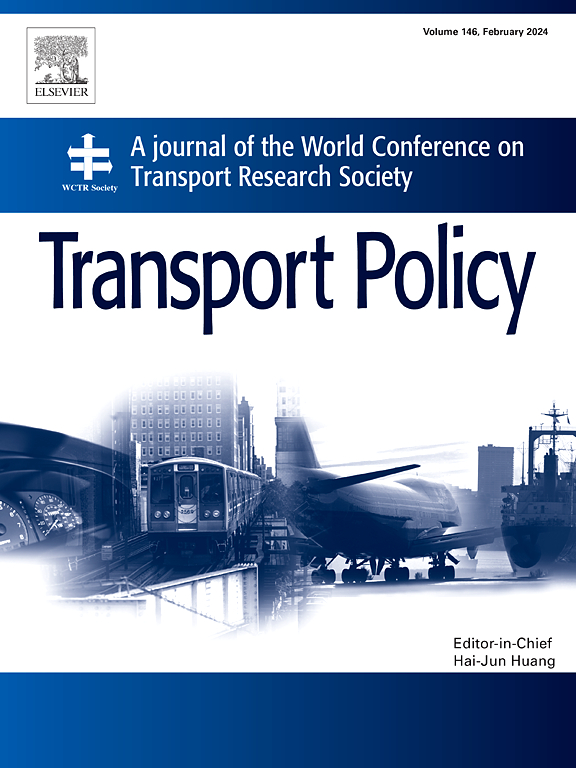AIS data-driven assessment of shore side electricity's emission reduction potential in China
IF 6.3
2区 工程技术
Q1 ECONOMICS
引用次数: 0
Abstract
Emissions from ships at ports significantly affect air quality and public health. Shore side electricity (SSE) is a promising solution for mitigating these emissions. Based on Automatic Identification System (AIS) data and national grid emission factors, this study developed a bottom-up model to evaluate SSE's emission reduction potential. We compiled an emission inventory of container ships at 37 coastal ports in mainland China in 2022 and evaluated the effectiveness of SSE. Results show that the emissions of air pollutants (SO2, NOX, PM2.5, CO, and NMVOC) from these ships totaled 5.58 × 104 tons, while greenhouse gases (CO2, CH4, and N2O) totaled 2.90 × 106 tons. SSE implementation results in significant emission reductions, decreasing overall port emissions by approximately 58 % and berth emissions by nearly 90 %. However, due to substantial differences in port characteristics and regional grid energy structures, the emission reduction potential exhibits considerable heterogeneity across ports. Based on our analysis of emission reduction data across various ports, we propose three targeted strategies: First, at the regional level, in areas with cleaner grid structures and high port activity, SSE facilities should be prioritized. In contrast, in regions that rely on fossil fuels, a combination of clean-energy vessels and route optimization measures should be promoted. Second, at the policy level, it is recommended to stimulate enterprise investment by implementing tiered subsidies, preferential electricity tariffs, and enhanced regulatory oversight. Third, at the implementation level, a collaborative mechanism between ports and shipping companies should be established to jointly optimize the planning and operation of SSE facilities.
AIS数据驱动的中国岸电减排潜力评估
港口船舶排放的废气严重影响空气质量和公众健康。岸电(SSE)是一个很有前途的解决方案,以减少这些排放。基于自动识别系统(AIS)数据和国家电网排放因子,建立了自下而上的SSE减排潜力评估模型。我们编制了2022年中国大陆37个沿海港口集装箱船舶排放清单,并对SSE的有效性进行了评估。结果表明:船舶大气污染物(SO2、NOX、PM2.5、CO和NMVOC)排放总量为5.58 × 104吨,温室气体(CO2、CH4和N2O)排放总量为2.90 × 106吨。SSE的实施显著减少了排放,将港口总排放量减少了约58%,泊位排放量减少了近90%。然而,由于港口特征和区域电网能源结构的巨大差异,港口之间的减排潜力表现出相当大的异质性。基于对各港口减排数据的分析,我们提出了三个有针对性的策略:首先,在区域层面,在电网结构更清洁、港口活动高的地区,应优先考虑SSE设施。相比之下,在依赖化石燃料的地区,应推动清洁能源船舶与航线优化措施相结合。第二,在政策层面,建议通过实行分层补贴、电价优惠、加强监管等方式刺激企业投资。第三,在实施层面,建立港口和船公司之间的协作机制,共同优化SSE设施的规划和运营。
本文章由计算机程序翻译,如有差异,请以英文原文为准。
求助全文
约1分钟内获得全文
求助全文
来源期刊

Transport Policy
Multiple-
CiteScore
12.10
自引率
10.30%
发文量
282
期刊介绍:
Transport Policy is an international journal aimed at bridging the gap between theory and practice in transport. Its subject areas reflect the concerns of policymakers in government, industry, voluntary organisations and the public at large, providing independent, original and rigorous analysis to understand how policy decisions have been taken, monitor their effects, and suggest how they may be improved. The journal treats the transport sector comprehensively, and in the context of other sectors including energy, housing, industry and planning. All modes are covered: land, sea and air; road and rail; public and private; motorised and non-motorised; passenger and freight.
 求助内容:
求助内容: 应助结果提醒方式:
应助结果提醒方式:


